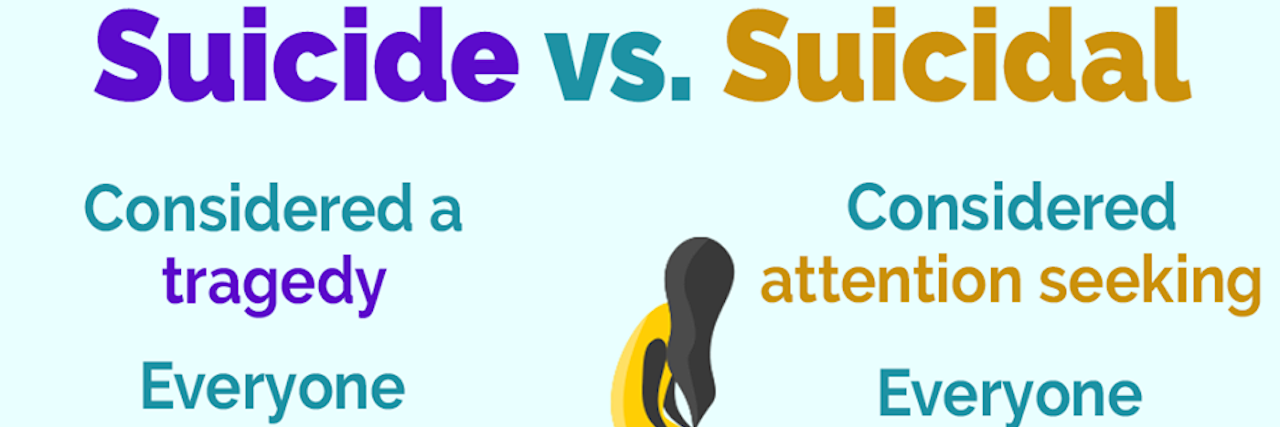The Depression Project, founded by two brothers who wanted to help people with depression, posted a graphic on Instagram that compares how people typically react when someone dies by suicide to how they actually treat those who are suicidal.
As the graphic explains, how people respond to suicide is often vastly different from how people are treated when they express suicidality. When someone dies by suicide, it is considered a tragedy. It’s common for people to wish they had seen the signs beforehand and that the individual had received help. Suicide deaths often leave a lot of unanswered questions for loss survivors, and these feelings are completely understandable, especially when we live in a world where suicide is rarely talked about and many individuals find themselves ill-equipped to support someone through a suicidal crisis.
In contrast, when an individual expresses they are experiencing active suicidality, they are often dismissed, even by professionals. They are often either involuntarily hospitalized — which removes any sense of environmental stability or support from loved ones — or dismissed as “attention-seeking.” It’s not uncommon for people to feel abandoned in the middle of their crisis as even well-meaning people express irritation and disbelief over what the individual says they are experiencing.
As I looked over this graphic, it resonated with me deeply. I couldn’t help but recall the responses I received when I reached out for help before my own eventual suicide attempt, just over four years ago, when I was 16 years old. The professional who blew me off as “too sensitive” was the same one who later diagnosed me with a disorder I had asked to be evaluated for in the months that led up to my suicide attempt. After my attempt, this professional later said my case was severe and they had no idea how they had missed it.
Similarly, the person in my life who dismissed my cries for help as “overdramatic” was the same person who, when I got home from the hospital following my attempt, asked why I didn’t say anything. I remember thinking at the time, “I did say something, repeatedly. Why weren’t you listening?”
Really, that question is probably the core of society’s inability to respond appropriately to an individual who is expressing suicidality.
Sure, we hear the words they are saying, but are we truly listening?
It’s a hard pill to swallow when we have to look at ourselves and recognize that we are not truly paying attention to individuals in crisis until it is too late.
As a society, we are not seeing them, we are seeing the stigma and misconceptions surrounding suicide.
We are seeing our own fear and denial.
We are seeing ableism.
To truly help an individual who is experiencing suicidality, both the professionals and loved ones in their lives have to be willing to put all of that aside and see them. We have to really listen to them.
It is cliché to say individuals who are experiencing suicidality don’t want to die, they just want the pain to stop. Although it oversimplifies suicide, it does have truth at its core. People who are experiencing suicidality are in an unbearable amount of pain, to the point where it truly feels that the best option in response to that pain is to end their lives.
So, once we have put aside our own misconceptions and biases, what do we do from there?
Often, just being there for someone makes a world of difference. You have to be willing to walk with them through the storms that have gotten them to this point.
Ask them what they need — often, they will tell you. They might need some time to rest, a chance to vent and get things off their chest, an additional therapy appointment, some time to themselves or a medication adjustment. We have to remember that every individual is the expert on themselves, and our ideas of what is helpful may not be what they need.
We need to stop stigmatizing individuals who express suicidality and start treating them as who they are: human beings who are experiencing an amount of pain that feels unbearable. Don’t be afraid to refer to the ways you would respond if someone was experiencing any other type of crisis — check on them, be there for them, listen, bring them food. Encourage people to seek out resources that are available to them, remember that professional support exists for a reason and that asking for help is a sign of strength, not one of weakness.
At the core of all of this, put humanity first. An individual in a suicidal crisis is just as human as anyone else, and they deserve to be treated as such — not alienated in the time when they need support most. While suicide deaths (and even attempts in which the individual survives) lead to a lot of questions, many of which often remain unanswered, asking wiser questions before someone reaches that point can be incredibly powerful, and may even save their life.
You can follow The Depression Project on Instagram here.
Lead photo via The Depression Project

